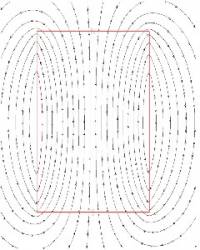EMF meters in vigils; what they measure

Geomagnetic field
Everyone is familiar with the way magnetic compasses face north. This happens because of geomagnetism - the Earth's own magnetic field. From the point of view of paranormal research, there are a few important things to consider about the geomagnetic field.
Ordinary EMF meters won't register it because, although it changes, it is generally over a scale of hours rather than seconds. From the point of view of an EMF meter, the field is essentially static.
What IS important is that if you move a meter through the geomagnetic field, it looks like a varying field. So, if you walk around with a meter you will often get a reading that stops when you do. The best advice, yet again, is to keep EMF meters stationary for the whole vigil.
What EMF meters measure
EMF meters are one of the most popular bits of equipment used in paranormal research (particularly ghost vigils). Some people even regard them as ghost detectors (see also here). But how many users actually understand what they are measuring?
Magnetic fields
Electromagnetism is one of the four fundamental forces of the universe. Though electricity and magnetism are commonly considered different things, they are two faces of the same coin. Yes, the force that allows a bar magnet (pic, left) to pick up pins is the same stuff that makes electric kettles boil water. Indeed, when a kettle boils it emits both an electric and a magnetic field (which EMF meters can detect).
Most EMF meters detect varying magnetic fields, though some can also detect varying electric fields. To detect a non-varying magnetic field (such as that from a permanent magnet) you need a magnetic sensor (see below) which is not usually sold as a meter and tends to be expensive.
Electromagnetic fields have direction as well as magnitude. This determines which way a magnetic object might move if it was being influenced by a field. Direction is important because EMF meter readings can change depending on which you you point the meter. It is best to keep meters absolutely still when taking a series of measurements, otherwise comparisons may be invalid.
Another important point about electromagnetic fields is that they fall off rapidly away from their source (according to the inverse square law). So a field at a distance of 2cm from a magnet is 10,000 times as strong as the same field 2m away. This means that if you use an EMF meter in the middle of a room, away from any electrical appliances, it will generally register just a weak background field.
Measuring Frequency
In order to measure non-varying magnetic fields and to obtain accurate frequency information about varying fields, you need a 'DC' sensor with a linear response. You can consider Hall Effect sensors but they are not very sensitive. The best sensors for parapsychological research is probably the fluxgate sensor, though it is rather expensive.
Induction
One of the most important concepts in electromagnetism is induction. It neatly demonstrates how electricity and magnetism are interchangeable. It also causes magnetic fields to appear in non-obvious places.
If you attach a voltmeter to a coil of wire, it will register nothing. That's unsurprising as there is no battery or any source of electrical current in the circuit. However, if you drop a bar magnet into the hole in the middle of the coil, the voltmeter will register a slight kick of electricity. This is the phenomenon known as induction. It is the principle behind generators, motors and a host of other electrical devices.
When an electrical conductor is touched by a varying magnetic field, an electrical voltage appears in the conductor. The conductor doesn't have to be magnetic, just an electrical conductor (so copper wire or pipes will do). What's more, the electric current generated will then produce its own magnetic field. That's because an electrical current always produces a magnetic field.
What this means for vigils is that if there is a varying magnetic field present, it may generate further fields in any electrical conductors present, such as copper plumbing. However, the effect is slight. Unless there are coiled conductors present, induced currents and magnetic fields are likely to be tiny compared with the main field. If you wave a magnet at a straight wire you'll be lucky to register anything.